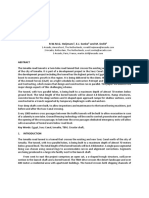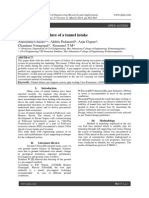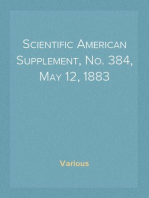FB6 05 Steiner
FB6 05 Steiner
Uploaded by
gaddargaddarCopyright:
Available Formats
FB6 05 Steiner
FB6 05 Steiner
Uploaded by
gaddargaddarCopyright
Available Formats
Share this document
Did you find this document useful?
Is this content inappropriate?
Copyright:
Available Formats
FB6 05 Steiner
FB6 05 Steiner
Uploaded by
gaddargaddarCopyright:
Available Formats
STEINER, EDLMAIR AND VERGEINER: PIPE-JACKING VERSUS CONVENTIONAL TUNNELLING
Confrontation of both methods at the Cable Tunnel System Graz Main Railway Station
By Helmut Steiner, Gerald Edlmair and Ralf Vergeiner
he upgrading of the existing railway properties of Graz Main Railway Station and therefore the increasing infrastructure requirements necessitate new data and power links. Additionally, the existing southbound railway line Sdbahn, the regional railway to Kflach and the new Koralmbahn Graz Klagenfurt will also be integrated to the existing and new facilities. The main cables are 15 kV traction power and 110 kV high voltage supply cables and multitudinous links for the railway control systems like data and telephone cables. Due to the dense arrangement of the existing facilities on the surface, such as railway tracks, buildings, platforms, a shallow placement of the cables was impossible. Therefore an underground solution with two different orientated tunnels was designed, which was later on constructed during unrestricted railway operation at the Graz central station. These structures consist of the 877 m longitudinal Main Cable Tunnel, the 85 m Cross Cable Tunnel, three access shafts, several cable ducts to existing facilities and an underground connection between the cross tunnel and the basement of the station building (Figures 1, 2, 11 and 12).
Description of both tunnelling methods
During preparation of the final design a conventional tunnelling method and a shield tunnelling method were considered. The costs for both methods were estimated to be similar. Hence it was decided to prepare tender documents for both methods (4). The tenderer could either select one of the two methods or bid for both methods. Additionally the tender documents also contained specifications for alternative offers.
Cross section
The cross section was designed to meet the requirements of a clearance profile of 1 m width and 2.1 m height, twelve cable trays on the walls and three cable ducts in the invert for 15 and 110 kV power cables (Figure 3).
Excavation methods
The excavation equipment had to be suitable for the geological situation with quaternary sandy gravel, silty gravel, silt and sand lenses, occasionally stones/blocks up to several dm diameter
auf den Bahnbetrieb, Vortriebskosten, allgemeine Sicherheitsbetrachtungen werden nher betrachtet und Vergleiche zwischen den beiden unterschiedlichen Vortriebsmethoden gezogen. The increasing infrastructure requirements of Graz main railway station required a longitudinal Main Cable Tunnel with 877 m in length and driven with pipe jacking by installing precasted concrete pipes and utilizing an open hooded shield (3.18 m internal diameter) for excavation. The Cross Cable Tunnel (85 m length) was driven by conventional excavation utilizing NATM support and a final shotcrete lining. The headings of the two tunnels had to be driven through quaternary sediments above the ground water table with an overburden varying from 3 to 14 m. As both excavation methods were carried out with similar cross sections (approximately 12 to 13m2 excavation section) and under similar ground conditions, a reliable comparison of both methods is possible. The paper includes technical and economical aspects, with the main focus on the comparison between prognosis and encountered conditions. Additionally following aspects like rates of advance and construction time, surface settlements and their effect on the railway operation, construction costs as well as general safety aspects are worked out and compared between the two different tunnelling methods.
FELSBAU 23 (2005) NO. 6
Rohrvorpressung oder NT-Vortrieb Gegenberstellung der beiden Vortriebsmethoden am Beispiel des Leitungskollektorensystems Graz Hauptbahnhof
Der steigende Bedarf an Kabelwegen im Bereich des Grazer Hauptbahnhofs machte es erforderlich, unter den bestehenden Gleisanlagen einen kontinuierlich aufgefahrenen Lngskollektor (Rohrvorpressung DN 3 180 mit offenen Haubenschild, Lnge 877 m) und einen rechtwinkelig davon abzweigenden, zyklisch vorgetriebenen Querkollektor (Lnge 85 m) zu errichten. Diese Vortriebe wurden bei berdeckungen von 3 bis 14 m in den wrm-glazialen Terassenschottern des Grazer Felds ausgefhrt. Da die beiden Vortriebsmethoden unter gleichen beziehungsweise hnlichen Untergrund- und nahezu identischen Querschnittsverhltnissen (etwa 12 bis 13 m 2 Ausbruchquerschnitt) zur Anwendung kamen, war es abschlieend mglich, vergleichende Betrachtungen hinsichtlich technischer und wirtschaftlicher Gesichtspunkte durchzufhren. Spezielles Augenmerk wird auf den Vergleich zwischen den vorab gettigten Prognosen und den vor Ort angetroffenen Verhltnissen und den dabei gemachten Erfahrungen gelegt. Die Aspekte Vortriebsleistung und Bauzeitvergleich, Oberflchensetzungen und die Auswirkungen
27
PIPE JACKING
Pipe-Jacking versus Conventional Tunnelling
STEINER, EDLMAIR AND VERGEINER: PIPE-JACKING VERSUS CONVENTIONAL TUNNELLING
PIPE JACKING
Fig. 1 Top view of the Cable Tunnel System Graz Main Railway Station. Bild 1 Luftbild des LeitungskollektorenSystems am Grazer Hauptbahnhof. Fig. 2 Top view detail of the Main and the Cross Cable Tunnel. Bild 2 Luftbilddetail des Lngs- und Querkollektors. Fig. 3 Cross sections for conventional tunnelling and in case of shield excavation. Bild 3 Regelquerschnitte fr zyklischen und kontinuierlichen Vortrieb.
28 FELSBAU 23 (2005) NO. 6
STEINER, EDLMAIR AND VERGEINER: PIPE-JACKING VERSUS CONVENTIONAL TUNNELLING
Fig. 4 Schematically longitudinal and cross section for conventional tunnelling. Bild 4 Schematischer Lngs- und Querschnitt den zyklischen Vortrieb betreffend.
Fig. 5 Supporting works at conventional drive. Bild 5 Sicherungsarbeiten beim zyklischen Vortrieb.
so called Murnockerl and maybe local areas with conglomerates (6). Also further anthropogenic material in areas with low overburden and the possibility of relics from the 2nd world war had to be considered. As the ground water table is below the tunnel, only seepage water was expected. For conventional excavation a intersection of the cross section in the upper top heading section and the combined bench/invert section was foreseen. The maximum distance between tunnel face and invert closure was defined to
be less than 4 m (Figures 4 and 5). The surface settlements were estimated to be less than 10 mm. The shield construction applied was an open hooded shield (1). The accessibility of the tunnel face was a precondition for the method in order to remove anthropogenic material upon requirement. The basic design parameters of the shield are 72 inclined cutting edge, a longitudinal cutting head, three forepoling blades in the roof section, three breasting plates to support the upper face section and a horizontal intersec-
Fig. 6 Schematically longitudinal section through the open hooded shield. Bild 6 Schematischer Lngenschnitt durch das offene Haubenschild.
FELSBAU 23 (2005) NO. 6
29
PIPE JACKING
STEINER, EDLMAIR AND VERGEINER: PIPE-JACKING VERSUS CONVENTIONAL TUNNELLING
PIPE JACKING
tion of the face called table (Figures 6 and 7). The expected surface settlement in case of shield excavation was between 20 and 30 mm.
Tunnel lining
For conventional tunnelling a single shell shotcrete lining, thickness 0.25 m, lattice girders and two layers of wire mesh were designed. As there were no special requirements concerning evenness and water tightness of the cable tunnel, no final lining was necessary. In case of shield excavation a segmental lining, thickness 0.25 m, was defined in the tender documents. Within the alternative tender the segmental lining was replaced by precasted concrete pipes with 3.68 m outer diameter, 3.2 m length, 0.25 m thickness and 21.8 t weight (2, 3).
Fig. 7 View through the open shield to the excavation face. Bild 7 Blick durch das offene Schild in Richtung Ortsbrust.
Forepoling
The forepoling for conventional tunnelling was designed by the use of steel sheets (t = 5 mm, L = 2 to 2.5 m, b = 0.22 m, up to 30 pcs) or forepoling piles (d = 26 mm, L = 2.3 to 3.5 m, 25 to 40 pcs). The decision weather to use sheets or piles was made on site, depending on the soil density (see Figures 4 and 5). The shield was equipped with three blades in the roof section which were set with hydraulic jacks with a maximum stroke of 0.6 m (see Figure 6).
Face stability
The face stability for conventional tunnelling was ensured by intersection of the cross section in the upper top heading section and the combined bench/invert section, a supporting core and further face support by shotcrete and wire mesh (see Figures 4 and 5). In case of shield excavation the inclined tunnel face (between 40 and 72), the horizontal intersection (table) to create an upper support body of ground material and the three breasting plates for face support in case of a longer excavation stop, guaranteed the face stability (see Figures 6 and 7).
Additional measures ahead of excavation works
Experience shows that within the well graded soil, sometimes lenses of non-cohesive rounded gravel occur. Though these gravels were not encountered within the site investigation programme, their existence had to be expected. Uniform sized layers could have a non-cohesive flowing behaviour and might jeopardize the stability of the tunnel face. As a precautionary measure grouting ahead of the tunnel face was carried out. Within the design of the conventional excavation method, grouting was foreseen by means of 6 m grouting lances. The lances are set every second round and grouted with low pressure to improve the abutment area of the forepoling.
Fig. 8 Shield drive performance per day and net shield drive performance per hour. Bild 8 Schildvortriebsleistungen pro Tag und netto Schildvortriebsleistungen pro Stunde.
30 FELSBAU 23 (2005) NO. 6
STEINER, EDLMAIR AND VERGEINER: PIPE-JACKING VERSUS CONVENTIONAL TUNNELLING
Estimated advance rates
The advance rates for conventional tunnelling were estimated to be between 2.5 and 3.5 m per day. For shield excavation the rates were estimated to be about 8 m/d. Due to the lower advance rates for conventional tunnelling two drives would be necessary to meet the time schedule.
Additional safety measures
World War II relics Graz Central Station and the nearby factories were subject to heavy bombing in the years 1944 to 1945 (5). Experience shows an percentage of about 10 to 15 % of the bombs were duds. Several areas and points were traced by the department of civil defence in Graz where duds were thought to be. As these areas covered nearly the whole project area, it was decided to carry out a systematic exploration by means of a magnetic field probe. With this method three possible points were traced and later on explored by means of test pits. One of the pits contained a 500 kg dud, which was deactivated by an expert from the ministry of the interior. Monitoring The monitoring for conventional tunnelling consisted of deformation measurements of shotcrete lining and of ground and track settlements. The monitoring for shield excavation consisted only of surface measurements of ground and track settlements. In both cases the inclination of railway catenary masts in critical excavation phases are monitored around the clock.
The first days were embossed by a very slow advance because equipment like the conveyor belt had to be installed simultaneously. But after a few days, on the 1st of October 2004 the excavation velocity reached the overall peak with 23 m/d due to favourable geological conditions and short mucking times (Figure 8). From chainage 230 m on increasing jacking pressures up to a level of over 500 bar and probably also the bended lining at the area of the Middle Shaft led to much lower advance rates than before. Around the 18th of November 2004 the shield advance reached again peak values up to 22 m/d although the mucking distance was fairly long (approximately 650 m). It seemed that at this part of the drive the excavation crew got used to the driving conditions, which could be interpreted as learning curve. The late rising of the learning curve is probably the result of unexpected unfavourable face conditions and that the jacking pressures were on their limit. Finally on 6th of December 2004 the shield reached successfully the target shaft north. It was intended to create a more or less homogeneous injection umbrella along the whole tunnel roof by drilling injection pipes in a certain grid with following grouting. During excavation
Fig. 9 Detail of the excavation face with partly solidified soil by grouting material Mixed Face Conditions. Bild 9 Detail der Ortsbrust mit teilweise durch Injektionsgut verfestigtem Boden.
Conditions and excavation velocity at the longitudinal Main Cable Tunnel
According to the Austrian Flexible Model of Construction Time the average mechanical tunnel drive had been offered by the contractor with a daily rate of 9.5 m. This rate already included the launching of the tunnelling machine, all calculated interruptions due to the working process, geological problems, predicted downtimes, reinstalling of the machinery and the refilling of the ring space. The real net tunnelling advance was calculated by the contractor with approximately 17 m/d. The daily excavation works were carried out on a 24 hour basis, three shifts eight hours each.
FELSBAU 23 (2005) NO. 6
31
PIPE JACKING
For shield excavation the underground grouting by use of lances out of the shield was estimated to be not economical because it would slow down the advance rate in a significant degree. Hence it was decided to carry out grouting measures from the surface. Expected problems were the spoiling of railway ballast substructure with grout and the interference of the grouting works with the railway operation.
STEINER, EDLMAIR AND VERGEINER: PIPE-JACKING VERSUS CONVENTIONAL TUNNELLING
PIPE JACKING
Conditions and excavation velocity at the mined Cross Cable Tunnel
The mined tunnel part of this project could be finished without any problems, except for steel lagging problems at one short part of the tunnel due to big stones in the tunnel perimeter. After changing steel lagging to forepoling piles no further problems were encountered. Because of the very small tunnel profile and the very short learning time for the tunnel crew the average driving performance was approximately 3 m/d.
Comparison of the excavation velocities
A theoretical comparison of the overall construction time based on the actual advance rates shows, that two conventional drives (north and south) for the longitudinal Main Cable Tunnel, would have shown the same construction time as a shield drive (approximately 180 d). Manufacturing time as for the shield was not needed in the case of conventional tunnelling which had positive effects on construction time (Figure 10).
Fig. 10 Theoretical comparison of construction time between shield and conventional excavation at the Main Cable Tunnel. Bild 10 Theoretischer Bauzeitvergleich zwischen zyklischem und kontinuierlichem Vortrieb beim Lngskollektor.
it was visible that wide areas around the roof were not injected because of the compactness of the ground. But also loose gravel layers were encountered uninjected possibly due to a too wide drilling grid (Figure 9). Unexpected changing of the ground compactness led to a reduction of the drive velocity as well as the above average maintenance times. Also the bentonite slurry used as a lubricant film around the jacking pipes could not built up properly due to permeable gravel layers in the quaternary sediments. The effects of this behaviour were high jacking pressures due to the high friction between the concrete pipes and the surrounding soil. Maintenance and downtimes calculated by the contractor have been exceeded significantly (7).
Settlements
Settlements encountered at the longitudinal Main Cable Tunnel
From the beginning of excavation it had to be learned that the geological conditions changed suddenly in an unpredictable way. The geotechnical safety management plan has foreseen that the normal settlement values would not exceed 10 mm. The 1st level alert criterion was reached
Fig. 11 Longitudinal section of the Main Cable Tunnel including geology and vertical settlements. Bild 11 Schnitt durch den Lngskollektor Darstellung der Geologie und der Setzungen.
32 FELSBAU 23 (2005) NO. 6
STEINER, EDLMAIR AND VERGEINER: PIPE-JACKING VERSUS CONVENTIONAL TUNNELLING
Fig. 12 Longitudinal section of the Cross Cable Tunnel including geology and vertical settlements. Bild 12 Schnitt durch den Querkollektor Darstellung der Geologie und der Setzungen.
by exceeding 10 mm surface settlements at the driving area and 20 mm 10 m behind the face. The 2nd level alert criterion has been triggered by reaching 50 mm and the 3rd criterion by exceeding 50 mm and posing effects to the safety of people or structures. Sudden inrushes of mostly loose gravel always triggered the 3rd level alert criterion. Fortunately these occurrences did not effect the surface immediately. Volume losses in front of the excavation face spread slowly within one to two days to the surface, depending on the overburden. So there was always enough time to inform the management of Graz Main Station. The average settlements had been measured with 40 to 60 mm at the area of overburden between 3.5 and 7.5 m (Figure 11). Afterwards the volume losses had to be filled up with cement grout from the surface to prevent further settlements and the tracks had to be readjusted by a ballast tamping machine.
could be prevented when passing difficult geological conditions. The maximum settlements at the surface have been measured with 9 mm, which did not really effect the railway tracks (Figure 12). The excavation of the cross passage could be finished without interruption of the train sequence above.
Comparison of settlements
At comparable tunnel sections by shield driving and by conventional tunnelling with similar overburden and geology one can clearly see a difference on the surface effects between the two methods. Similar areas are for the Main Cable Tunnel from tunnel metre 510 to the end of the drive (tunnel metre 877) and for the cross passage from the beginning to the end. Both zones have been excavated with overburdens from 3.5 to approximately 7.5 m. Primary settlements Whereas the excavation of the cross passage could be finished without interruption of the regular train operation, settlements above the shield drive led to continued interruption of train service on tracks above. The maximum vertical surface displacements have been measured with only 9 mm at the cross passage area. The peak
FELSBAU 23 (2005) NO. 6
Settlements encountered at the Cross Cable Tunnel
The same alert level criteria were valid for the cross passage, excavated by conventional mining technique. By using forepoling items like steel lagging and forepoling piles volume losses
33
PIPE JACKING
STEINER, EDLMAIR AND VERGEINER: PIPE-JACKING VERSUS CONVENTIONAL TUNNELLING
PIPE JACKING
value of settlements at the shield driving area was more than 200 mm, the average between 40 and 60 mm. Secondary consolidation Whereas the secondary consolidation stopped immediately after ring closure at the mined tunnel part, the consolidation above the shield drive kept on for weeks. The bulking of the surrounding soil caused by volume loss during shield drive led to excessive secondary consolidation. Three month after penetrating shaft north end of shield drive the average was measured with 8 mm at the area mentioned above.
Summary
According to construction costs and time there is no significant difference between the two methods. However a glance at surface settlements and its effects on railway operation gives the mined method conventional tunnelling a clear preference for projects with similar boundary conditions in the future. The constant threat of surface instability above the tunnel drive caused by potential sudden inrushes of ground material is unfavourable for a reliable safety management on site. The comparison resumes as follows: Similar costs per metre, Similar total construction time, considering preparation time, maintenance time and downtime, Absolute advantage for the conventional method concerning surface settlements. The surface settlements of the conventional method add up to only 10 to 20 % of the shield drive, Absolute advantage for the conventional method concerning the face stability and the minimization of interference on the railway structures, Absolute advance for the shield method concerning the working conditions for the tunnel crew, Advance for the shield method for the later maintenance and equipment installations in the cable tunnels due to the perfect even shaped concrete surface.
References 1. Steiner, H. ; Vigl, A. ; Vergeiner R. ; Hrlein N.: Leitungskollektor Graz Hbf. Pressrohrvortrieb DN 3180 mit offenem Haubenschild. Felsbau 23 (2005) Nr.5, S.76-82. 2. Hrlein, N. ; Ppperl, R. ; Steiner, H. ; Schneider, K.: Der Kabelkollektor Graz Hauptbahnhof. Beton Zement 4/2004, S. 42-45. 3. Kolic, D. ; Hrlein, N. ; Schneider, K. ; Steiner H.: Competitiveness of Pipe-Jacking Tunnels. Symposium Keep Concrete Attractive, Budapest 2005. 4. Fischer, P. ; Bauer, F.: Zuschlagskriterien zur Beurteilung von Alternativangeboten am Beispiel des Wienerwald Tunnels. Tagungsband sterreichischer Tunneltag 2004, S. 87-90. 5. Brunner, W.: Bomben auf Graz. Die Dokumentation Weissmann. Graz: Leykam Verlag, 1989. 6. sterreichische Bundesbahnen: Baugeologische Dokumentation und Vortriebsbetreuung des Leitungskollektors Graz Hbf. Mag. Erhard Neubauer ZT GmbH, 2005 (intern). 7. sterreichische Bundesbahnen: Geotechnische Dokumentation Leitungskollektors Graz Hbf. iC consulten, 2005 (intern). Authors Dipl.-Ing. Dr. mont. Helmut Steiner, BB-Infrastruktur Bau AG, Geschftsbereich Projekte, Projektleitung Koralmbahn 1, Griesgasse 11 / 2. Stock, A-8020 Graz, Austria, E-Mail helmut.steiner@hl-ag.com; Dipl.-Ing. Gerald Edlmair, Laabmayr & Partner, Preishartlweg 4, A-5020 Salzburg, Austria, E-Mail office@laabmayr.at; Dipl.-Ing. Ralf Vergeiner, iC consulenten, Kaiserstrae 45, A-1070 Vienna, Austria, E-Mail r.vergeiner@ic-vienna.at
Working conditions for the tunnel crew
Shield drive
The soils encountered usually during the shield drive had a constant humidity so that no dust could develop. The shielded space showed excellent air conditions for the tunnelling crew during the whole drive and also the staffs access to the shield was mostly dry and clean. Although sudden inrushes of soil into the shield occurred, the staffs health and safety were never at risk due to the sufficient distance between the machine driver and the excavation face.
Conventional tunnelling
Due to small portions to be supported step by step this could only be managed by application of dry shotcrete. During spraying and significant time after the small tunnel profile was still full with dust although the tunnel was ventilated. Especially to the nozzle man the situation was quite uncomfortable because of very reduced visibility during placing the shotcrete. The stability of the tunnel itself was never in danger.
Theoretical comparison of excavation costs
A retrospective comparison show similar costs of about 5 100 EUR per metre for both methods. The sum includes tunnelling costs, costs for shield and mining equipment, cost for site facilities, time related cost, cost for muck transport, costs for surface grouting and costs for exploration on war legacies.
www.vge.de
34 FELSBAU 23 (2005) NO. 6
You might also like
- Sultan Izmit BridgeDocument10 pagesSultan Izmit BridgeMuhammad Umar RiazNo ratings yet
- Class Notes On Underground Excavations in Rock (2006)Document134 pagesClass Notes On Underground Excavations in Rock (2006)Alma Ramić100% (1)
- Geotechnical Baseline ReportDocument37 pagesGeotechnical Baseline Reportgaddargaddar100% (1)
- Interturn Short-Circuit Detector For Turbine-Generator Rotor WindingsDocument6 pagesInterturn Short-Circuit Detector For Turbine-Generator Rotor WindingsEng Bagaragaza Romuald100% (2)
- Modeling of Pipe Arch Canopies in Shallow Soft Ground Tunnels Constructed by Sequential Excavation MethodsDocument8 pagesModeling of Pipe Arch Canopies in Shallow Soft Ground Tunnels Constructed by Sequential Excavation MethodsKristi GonzalesNo ratings yet
- Computational Model and Charts For Cut-and-Cover TunnelsDocument18 pagesComputational Model and Charts For Cut-and-Cover Tunnelskabasy2015No ratings yet
- Bridges Spanish HSRLDocument13 pagesBridges Spanish HSRLVelugoti VijayachandNo ratings yet
- Ground Deformations Above A Large Shallow Tunnel EDocument10 pagesGround Deformations Above A Large Shallow Tunnel ECarlos ValdésNo ratings yet
- Cheng Et Al (2021)Document12 pagesCheng Et Al (2021)shiv shankar KumarNo ratings yet
- ICSV10 mfmh2Document8 pagesICSV10 mfmh2danielNo ratings yet
- Primary and Secondary Tunnel Lining Design Methodology-2Document3 pagesPrimary and Secondary Tunnel Lining Design Methodology-2grktnc100% (1)
- Palau Creep Report Concreep 08-09-27Document32 pagesPalau Creep Report Concreep 08-09-27Ricox4444No ratings yet
- A Monumental Bridge With A Problem Caused by Oversights in DesignDocument18 pagesA Monumental Bridge With A Problem Caused by Oversights in Designevan_arendseNo ratings yet
- Elplanation of Excessive Long Time Deflections of Collapsed Record Span Box Girder BridgesDocument32 pagesElplanation of Excessive Long Time Deflections of Collapsed Record Span Box Girder BridgesEr.Praveen RajNo ratings yet
- Cut and Covers TunnelsDocument18 pagesCut and Covers TunnelsRene RoblesNo ratings yet
- Bond Street Station Upgrade - Using 3D Analysis To Optimise Tunnel DesignDocument3 pagesBond Street Station Upgrade - Using 3D Analysis To Optimise Tunnel Designjohnsmith1980No ratings yet
- Temporary Excavation Support System For A New Railway Bridge and Highway Underpass in Pittsburgh, Pennsylvania by Andrew G. Cushing and Christopher J. LewisDocument8 pagesTemporary Excavation Support System For A New Railway Bridge and Highway Underpass in Pittsburgh, Pennsylvania by Andrew G. Cushing and Christopher J. LewisAndrew CushingNo ratings yet
- CV24Document11 pagesCV24Anonymous kBl0u3nNo ratings yet
- Uncased PipelineDocument10 pagesUncased Pipelinelarry.grigioniNo ratings yet
- Large Diameter Pipe Roof Box Excavation For Passenger Linkway TunnelDocument14 pagesLarge Diameter Pipe Roof Box Excavation For Passenger Linkway TunnelMH Enc Const TrdNo ratings yet
- PJ2021 V17 N1 Award of Excellence Rod El Farag Cable Stayed BridgeDocument6 pagesPJ2021 V17 N1 Award of Excellence Rod El Farag Cable Stayed Bridgedewei chenNo ratings yet
- Challenging Features in Design and Execution of A Low Overburden Underpass - A Case History From Malaysia: PLUS North-South HighwayDocument10 pagesChallenging Features in Design and Execution of A Low Overburden Underpass - A Case History From Malaysia: PLUS North-South HighwayYap Wen KhongNo ratings yet
- Bappler - 2017 TBM APPLICATIONS FOR SHORT TUNNELSDocument9 pagesBappler - 2017 TBM APPLICATIONS FOR SHORT TUNNELSPaloma CortizoNo ratings yet
- Excessive Deflections of Record-Span Prestressed Box GirderDocument11 pagesExcessive Deflections of Record-Span Prestressed Box GirderrammirisNo ratings yet
- Prediction of Ground Subsidence Associated With Construction of Greater Cairo Metro - Line 3Document21 pagesPrediction of Ground Subsidence Associated With Construction of Greater Cairo Metro - Line 3Sayed ElarabyNo ratings yet
- 264 MARCLAY The New Linth-Limmern Hydro-Power Plant ColourDocument4 pages264 MARCLAY The New Linth-Limmern Hydro-Power Plant Colourrolfi66No ratings yet
- Experimental Determination of Damping Ratio of A Transparent Pier With Steel Piles and Reinforced Concrete BoarDocument13 pagesExperimental Determination of Damping Ratio of A Transparent Pier With Steel Piles and Reinforced Concrete BoarAngga Fajar SetiawanNo ratings yet
- Ismailia Road Tunnel Crossing The Suez Canal PDFDocument8 pagesIsmailia Road Tunnel Crossing The Suez Canal PDFRonald HeijmansNo ratings yet
- Cevni Kisobran PDFDocument15 pagesCevni Kisobran PDFVila DajanaNo ratings yet
- Rocker Pipe PDFDocument8 pagesRocker Pipe PDFMahmoud GwailyNo ratings yet
- The New Balanced Cantilever Bridge Over Acheloos RiverDocument9 pagesThe New Balanced Cantilever Bridge Over Acheloos Riverhugojameswood100% (1)
- Paper - TopProject - CoulterMartinDocument9 pagesPaper - TopProject - CoulterMartinherdiana_hanifahildaNo ratings yet
- Pubb-0354-L-Design and Construction of Large Tunnel Through Active Faults - A Recent ApplicationDocument14 pagesPubb-0354-L-Design and Construction of Large Tunnel Through Active Faults - A Recent Applicationengr_usman04No ratings yet
- The Elbe Tunnel HamburgDocument18 pagesThe Elbe Tunnel HamburgDebbie FrancisNo ratings yet
- 811 Ecsmge 2019 Topolnicki FinalDocument9 pages811 Ecsmge 2019 Topolnicki FinalIslam DawoodNo ratings yet
- Circular Precast Concrete ManholesDocument5 pagesCircular Precast Concrete ManholesAnthony Quintua PatinoNo ratings yet
- Caso 1 - Tunel Sismico BoluDocument4 pagesCaso 1 - Tunel Sismico BoluCarlos Catalán CórdovaNo ratings yet
- Joint-Free Experimental Prestressed PavementDocument15 pagesJoint-Free Experimental Prestressed Pavementunix0123No ratings yet
- 10 1002@suco 201600057Document41 pages10 1002@suco 201600057Sairam KatikalaNo ratings yet
- External Prestressing Bavarian ExamplesDocument10 pagesExternal Prestressing Bavarian ExamplesAna CastroNo ratings yet
- Dynamic Behaviour of The Jamuna Multi-Purpose Bridge Considering Dif-Ferent Scour DepthDocument7 pagesDynamic Behaviour of The Jamuna Multi-Purpose Bridge Considering Dif-Ferent Scour DepthSunita AgarwalNo ratings yet
- A Tonon2011Document14 pagesA Tonon2011zollyyNo ratings yet
- Sunshine Skyway Bridge AnalysisDocument9 pagesSunshine Skyway Bridge AnalysisMarco Bourdon100% (1)
- OTC 13994 Brutus Export Pipelines - Improvement Opportunities and Challenges in Deepwater Pipeline InstallationDocument12 pagesOTC 13994 Brutus Export Pipelines - Improvement Opportunities and Challenges in Deepwater Pipeline InstallationBalan14No ratings yet
- Proprenter Wagner Semmering Base Tunnel 17 Miles of SEM and TBM Tunneling Under Challenging Conditions in AustriaDocument10 pagesProprenter Wagner Semmering Base Tunnel 17 Miles of SEM and TBM Tunneling Under Challenging Conditions in AustriasCoRPion_trNo ratings yet
- Asce Pipelines 2013 Clsm and Modified Marston Predicted Load PaperDocument12 pagesAsce Pipelines 2013 Clsm and Modified Marston Predicted Load PaperRoger FedererNo ratings yet
- The Lully Viaduct, A Composite Bridge With Steel Tube TrussDocument11 pagesThe Lully Viaduct, A Composite Bridge With Steel Tube Trusssofronije2005No ratings yet
- Tunnel FailureDocument4 pagesTunnel FailurekzxeNo ratings yet
- Engineering Structures: Islam Ezzeldin, Hany El NaggarDocument15 pagesEngineering Structures: Islam Ezzeldin, Hany El NaggarEbrahim HassankhaniNo ratings yet
- Structural Analysis of Profiles PEDocument10 pagesStructural Analysis of Profiles PElfpachecoNo ratings yet
- 5546970Document19 pages5546970mahakassasNo ratings yet
- Cofferdams Supported by Removable Temporary Anchors A D Barley Reproduced From Natm May 1999Document10 pagesCofferdams Supported by Removable Temporary Anchors A D Barley Reproduced From Natm May 1999Kenny CasillaNo ratings yet
- Detailed Design of EuroTunnelDocument7 pagesDetailed Design of EuroTunnelNdanu MercyNo ratings yet
- Tunnels in Weak RockDocument15 pagesTunnels in Weak RockSandeep AggarwalNo ratings yet
- 25 Design Verification Challenges HPP CavernsDocument9 pages25 Design Verification Challenges HPP CavernsBhaskar ReddyNo ratings yet
- Design of Tail Race System of Rampur HEPDocument9 pagesDesign of Tail Race System of Rampur HEPengineerramanNo ratings yet
- A Short Guide to the Types and Details of Constructing a Suspension Bridge - Including Various Arrangements of Suspension Spans, Methods of Vertical Stiffening and Wire Cables Versus Eyebar ChainsFrom EverandA Short Guide to the Types and Details of Constructing a Suspension Bridge - Including Various Arrangements of Suspension Spans, Methods of Vertical Stiffening and Wire Cables Versus Eyebar ChainsNo ratings yet
- A Guide to Some of the Equations used in Constructing a Suspension BridgeFrom EverandA Guide to Some of the Equations used in Constructing a Suspension BridgeNo ratings yet
- Transactions of the American Society of Civil Engineers, Vol. LXVIII, Sept. 1910 The New York Tunnel Extension of the Pennsylvania Railroad. The Cross-Town Tunnels. Paper No. 1158From EverandTransactions of the American Society of Civil Engineers, Vol. LXVIII, Sept. 1910 The New York Tunnel Extension of the Pennsylvania Railroad. The Cross-Town Tunnels. Paper No. 1158No ratings yet
- Site InvestigationsDocument452 pagesSite InvestigationsgaddargaddarNo ratings yet
- Tunnel Depth - Def ModulusDocument7 pagesTunnel Depth - Def ModulusgaddargaddarNo ratings yet
- Sheffi Urban Trans NetworksDocument415 pagesSheffi Urban Trans NetworksShri Kant BansalNo ratings yet
- The Observational Method in Ground EngineeringDocument214 pagesThe Observational Method in Ground Engineeringgaddargaddar100% (1)
- Behaviour of Precast Reinforced Concrete Pile CapsDocument6 pagesBehaviour of Precast Reinforced Concrete Pile CapsgaddargaddarNo ratings yet
- Twin Nat M Tunnels PubDocument17 pagesTwin Nat M Tunnels PubgaddargaddarNo ratings yet
- Basic Concepts in Nonlinear Dynamics and ChaosDocument36 pagesBasic Concepts in Nonlinear Dynamics and Chaospperic13No ratings yet
- 01-The Observational Method in Ground EngineeringDocument75 pages01-The Observational Method in Ground EngineeringgaddargaddarNo ratings yet
- NATM Engineer: New Austrian Tunnelling MethodDocument6 pagesNATM Engineer: New Austrian Tunnelling MethodgaddargaddarNo ratings yet
- Geotechnical Model For Tunnels Supported by A Pipe UmbrellaDocument7 pagesGeotechnical Model For Tunnels Supported by A Pipe UmbrellagaddargaddarNo ratings yet
- Excavation MethodsDocument2 pagesExcavation MethodssheeeepNo ratings yet
- Rock Mass Classification: Neil BensonDocument56 pagesRock Mass Classification: Neil BensongaddargaddarNo ratings yet
- 10 AdachiDocument43 pages10 Adachigaddargaddar100% (1)
- A Correlation Between Dynamic Cone Penetrometer Values and PDocument8 pagesA Correlation Between Dynamic Cone Penetrometer Values and PgaddargaddarNo ratings yet
- Supports, Lining and VentilationDocument19 pagesSupports, Lining and VentilationgaddargaddarNo ratings yet
- Landsat7 HandbookDocument186 pagesLandsat7 HandbookNarangerel DavaasurenNo ratings yet
- DSI Boggo Road Busway AustraliaDocument1 pageDSI Boggo Road Busway AustraliagaddargaddarNo ratings yet
- 1 Hexahedral-Meshing Preprocessor - 3dshopDocument54 pages1 Hexahedral-Meshing Preprocessor - 3dshopgaddargaddarNo ratings yet
- Horizontal Cone Penetration Testing in SandDocument6 pagesHorizontal Cone Penetration Testing in SandgaddargaddarNo ratings yet
- NCP - Ineffective Breathing PatternDocument3 pagesNCP - Ineffective Breathing PatternJose Marlon CandelariaNo ratings yet
- Unit 9. Natural Disasters: The Test of The Grade 9Document6 pagesUnit 9. Natural Disasters: The Test of The Grade 9api-3755949No ratings yet
- VAL Team: Humidity Separators SF251/S PN 16 and PN 40Document2 pagesVAL Team: Humidity Separators SF251/S PN 16 and PN 40peyman mahinsaNo ratings yet
- Protein Synthesis EssayDocument5 pagesProtein Synthesis Essaymarybrownarlington100% (2)
- 26-d. Utility Expenses, TelephoneCommunication Services & Advertising Expenses-Jv EstrellaDocument80 pages26-d. Utility Expenses, TelephoneCommunication Services & Advertising Expenses-Jv Estrellajohn vincent estrellaNo ratings yet
- BS en 12396-2-1999Document10 pagesBS en 12396-2-1999DoicielNo ratings yet
- GroutingDocument15 pagesGroutingDev Thakkar100% (2)
- SynthesisDocument1 pageSynthesisorangeviewNo ratings yet
- Successful Networking How To Build New Networks For Career and Company ProgressionDocument209 pagesSuccessful Networking How To Build New Networks For Career and Company ProgressionTechBoy65No ratings yet
- BE553 Coursework Assessment 2023-2024 (BE553 - GC) - UploadedRDocument4 pagesBE553 Coursework Assessment 2023-2024 (BE553 - GC) - UploadedRkmm84195No ratings yet
- (NEW) Beyond Technical Analysis With Python - A C - Hayden Van Der Post-Dual-TranslatedDocument262 pages(NEW) Beyond Technical Analysis With Python - A C - Hayden Van Der Post-Dual-Translated1272930617wjj0% (1)
- Welfare SWFDocument34 pagesWelfare SWFAmanda WebbNo ratings yet
- Topic - Lesson 1 - Site of The First MassDocument7 pagesTopic - Lesson 1 - Site of The First MassLester SyNo ratings yet
- TDS 1169 1117Document3 pagesTDS 1169 1117angelito bernalNo ratings yet
- Assignment - Week 8 Type of Question: MCQ/MSQ: Course Name: Introduction To Machine Learning ClusteringDocument6 pagesAssignment - Week 8 Type of Question: MCQ/MSQ: Course Name: Introduction To Machine Learning ClusteringSURENDRAN D CS085No ratings yet
- Lab Practice Isothermal CSTRDocument11 pagesLab Practice Isothermal CSTRJosé Miguel Gómez LombóNo ratings yet
- Saudi Arabia Distribution CodeDocument87 pagesSaudi Arabia Distribution Codesaniya_mirza4100% (1)
- 9 UrinalsDocument16 pages9 UrinalsAhamed KyanaNo ratings yet
- Carbon Black-Evaluation of Standard Reference BlacksDocument3 pagesCarbon Black-Evaluation of Standard Reference BlacksinfoNo ratings yet
- Digital Signal Processing c1Document20 pagesDigital Signal Processing c1Meliza SiotingNo ratings yet
- Furious and FerociousDocument4 pagesFurious and FerociousXavier GuezalaNo ratings yet
- IDS 350PE Flyer D392004983 MKT 001Document2 pagesIDS 350PE Flyer D392004983 MKT 001Juan Mata100% (1)
- Horti-Crop Production CGDocument5 pagesHorti-Crop Production CGCarlz Brian100% (1)
- Agar Automatic Tank Dewatering ApplDocument4 pagesAgar Automatic Tank Dewatering ApplJADNo ratings yet
- An Analysis On The Three Main Problems of The Philippines Related To Political Economy and Its SolutionDocument24 pagesAn Analysis On The Three Main Problems of The Philippines Related To Political Economy and Its SolutionNoel IV T. BorromeoNo ratings yet
- Pride and Prejudice !Document8 pagesPride and Prejudice !DanielaNo ratings yet
- Bed 1st Year Assignments Jan 2019 (English)Document5 pagesBed 1st Year Assignments Jan 2019 (English)Trendy RexNo ratings yet
- Journal of Object Oriented Programming and Data StructureDocument2 pagesJournal of Object Oriented Programming and Data StructureTybca077Goyani VaidehiNo ratings yet
- Nahdatul Fikra M. Mas'Ud - UtsDocument6 pagesNahdatul Fikra M. Mas'Ud - UtsNahdatul FikraNo ratings yet














































































































